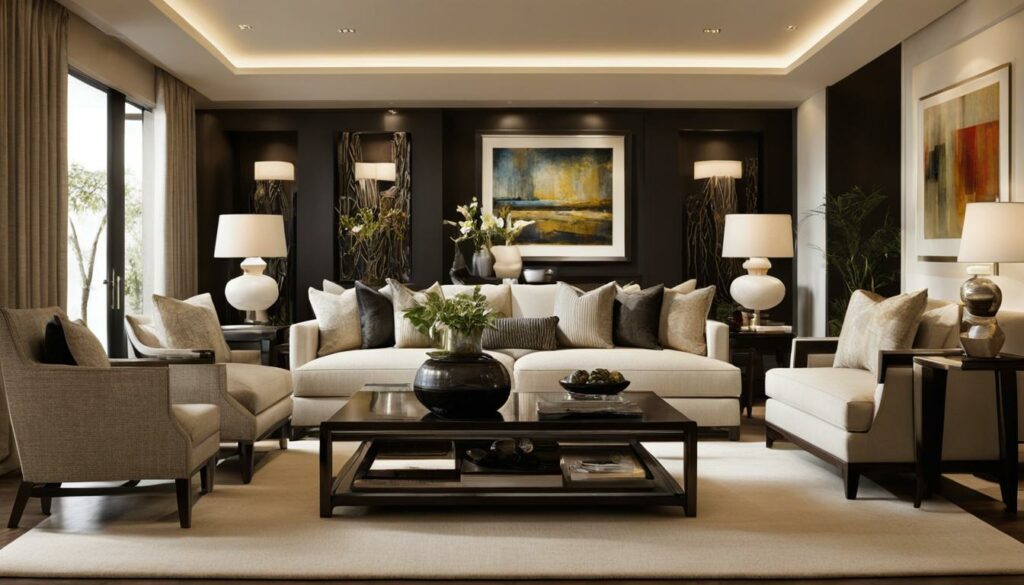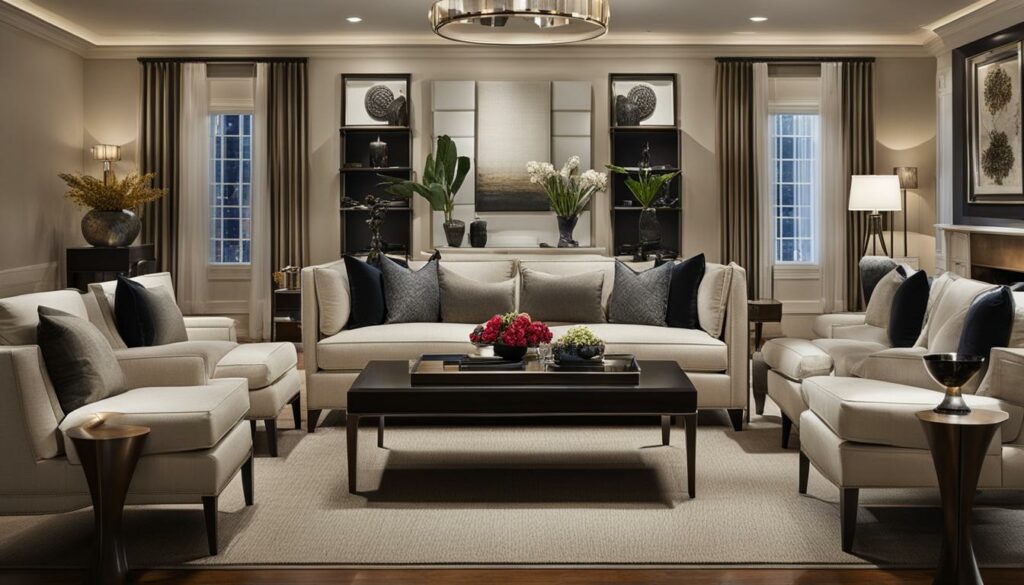Furniture arrangement can be a challenging task, but with the right tips and strategies, you can create a functional and stylish space that maximizes every inch of your room. As an interior design enthusiast, I’ve gathered expert advice from top designers, LuAnn McCants and Beth Reed, to bring you the most effective furniture arranging rules that they swear by.
When it comes to furniture arrangement, space planning and room layout are key factors to consider. Whether you’re redesigning a living room, bedroom, or home office, these tips will help you create a harmonious and inviting atmosphere that complements your personal style.
Key Takeaways:
- Measure the room and furniture before starting the rearrangement process.
- Create a focal point to bring visual interest to the space.
- Consider traffic flow and ensure pathways are wide enough for easy movement.
- Strive for balance and symmetry in your furniture arrangement.
- Vary the size and scale of furniture pieces to add visual interest to the room.
Measure and Assess the Space
Before diving into the furniture rearranging process, take the time to measure both the room and your furniture pieces. This step is essential to ensure that everything fits seamlessly and creates a harmonious spatial arrangement. Grab a tape measure, and let’s get started!
Begin by measuring the dimensions of the room. Note down the length and width of the space to have a clear understanding of its size. This information will help you make informed decisions when arranging the furniture later on.
Once you have the room measurements, it’s time to measure your furniture. Knowing the exact dimensions of each piece will allow you to assess whether it fits comfortably within the room or needs to be adjusted. Pay attention to the height, width, and depth of the furniture items and jot down these measurements for reference.
With the room and furniture measurements in hand, you can now start envisioning the spatial arrangement that suits your needs. Consider the different possibilities and limitations imposed by the room’s dimensions. Take note of any architectural features, such as windows or doors, as these may affect the placement of furniture.
When measuring and assessing the space, it’s crucial to factor in traffic flow. Ensure that pathways in the room are at least three feet wide to allow for easy movement and access to furniture. By considering traffic flow from the beginning, you can create a layout that promotes a seamless and comfortable flow of movement in the room.
Testing out your arrangement by hosting guests can provide valuable insight into how well the space accommodates its intended function and the flow of traffic. Observe if there are any areas of congestion or if the layout promotes a harmonious interaction between furniture and guests.
“Measure twice, arrange once” – Beth Reed
Take your time to measure and assess the space before jumping into rearranging the furniture. By doing so, you can lay the foundation for a well-planned and functional spatial arrangement that optimizes both aesthetics and usability.
Create a Focal Point
Every room needs a focal point – a standout element that captures attention and sets the tone of the space. Whether it’s a stunning fireplace, a captivating piece of art, or a unique furniture item, a focal point acts as the room’s centerpiece, adding depth and personality to the overall design.
To create a furniture focal point, select a standout piece that draws the eye and becomes the visual anchor of the room. Consider a statement sofa, an eye-catching coffee table, or a stylish accent chair. Place this larger furniture item strategically in the room, ensuring it becomes the immediate attention-grabber when entering the space.
“A focal point serves as the heartbeat of a room, guiding the furniture arrangement and creating a sense of purpose,” says LuAnn McCants, a renowned interior designer.
Once you’ve established the focal point, arrange the rest of your furniture around it. This ensures a visually cohesive and harmonious space. Start with the larger furniture pieces, such as sofas and chairs, positioning them in a way that complements and enhances the focal point. Then, layer in smaller chairs, accessories, and lamps to add depth and visual interest.
Avoid cluttering the room with too many furniture pieces. Instead, be strategic in editing the number of items to maintain a clean and balanced aesthetic. Remember, less is often more when it comes to creating a focal point and allowing it to shine as the room’s centerpiece.

Consider Traffic Flow
When arranging furniture in your room, it’s crucial to take into account the flow of traffic. Ensuring that the pathways are wide enough is essential for easy movement and furniture accessibility. Optimal traffic flow enhances the functionality and usability of the space, creating a comfortable and convenient environment.
To promote efficient traffic flow, aim for pathways that are at least three feet wide. This allows ample room for people to navigate around the furniture without feeling cramped or obstructed. Avoid placing large furniture pieces that could block the path and impede the movement within the room.
A well-designed layout should direct traffic around seating areas rather than through the middle. Position furniture in a way that guides guests around the room and facilitates seamless transitions between different areas.
To visually illustrate the importance of traffic flow in furniture arrangement, consider the following example:
| Furniture Placement | Traffic Flow |
|---|---|
| “The furniture is thoughtfully arranged along the walls, leaving a clear path for easy movement. The traffic flow remains unobstructed, allowing efficient access to all furniture pieces.” |
Balance and Symmetry
When it comes to creating a well-arranged room, balance is key. However, achieving balance doesn’t always mean perfect symmetry. While symmetrical designs work beautifully in formal rooms, you can still create a balanced furniture arrangement with asymmetrical designs.
To achieve balance, incorporate a mix of straight and curved lines in your furniture arrangement. Pair solid pieces with voids, such as open shelving or empty wall spaces. This creates contrast and visual interest in the room. Additionally, play around with different shapes and sizes of furniture to add depth and dimension.

By carefully considering the balance and symmetry in your room, you can create a visually appealing composition that promotes flow and interest. Remember, balance is about creating harmony and cohesion in your space, so don’t be afraid to explore asymmetrical designs for a unique and dynamic furniture arrangement.
Vary the Size and Scale
To add visual interest and depth to your furniture arrangement, it’s important to vary the size and scale of furniture pieces throughout the room. This creates a dynamic and appealing look that captures attention. Mixing larger and smaller items not only adds variety but also ensures that your eyes move up and down as you scan the space, enhancing the overall visual experience.
When arranging your furniture, consider pairing tall or large pieces with those of similar height to create balance and harmony. This creates a sense of cohesion and prevents any one piece from overpowering the room. Avoid placing two tall pieces next to each other, as it can disrupt the visual flow and make the room feel top-heavy.
To illustrate the impact of varying size and scale, consider the following example:
| Furniture Piece | Dimensions |
|---|---|
| Large Sectional Sofa | 96″W x 40″D x 35″H |
| Accent Chair | 30″W x 32″D x 35″H |
| Coffee Table | 48″W x 24″D x 18″H |
| End Table | 22″W x 22″D x 22″H |
“By incorporating a large sectional sofa as the centerpiece of the room and complementing it with smaller accent chairs and tables, you create a visually balanced composition. The size variation not only adds depth and dimension but also creates a captivating conversation area.”
Experiment with different combinations and placements of furniture pieces to find what works best for your space. Don’t be afraid to think outside the box and incorporate unique shapes and sizes. Remember, the goal is to create a visually interesting and harmonious furniture arrangement that brings your room to life.
Conclusion
Furniture arrangement is an art that requires thoughtful consideration and planning. By implementing these expert-approved tips, you can transform your room into a well-organized and efficient space that maximizes both functionality and style. Incorporate these furniture arrangement ideas to create an effortless layout that enhances the overall look and feel of your room.
Start by measuring the room and furniture to ensure a proper fit within the space. Consider traffic flow, allowing for wide pathways to promote easy access and movement. Create a focal point that draws the eye and anchors the room, whether it’s a fireplace, artwork, or a statement furniture piece.
Balance and symmetry are key elements in a well-arranged room. Achieve balance by incorporating a mix of straight and curved lines, pairing solids with voids, and using different shapes and sizes of furniture. Vary the size and scale of furniture pieces to add visual interest and depth, creating a dynamic arrangement.
With these strategies in mind, you can achieve a stylish and efficient furniture layout that enhances room organization and optimizes space utilization. Take the time to plan and implement these ideas, and you’ll be rewarded with a beautifully arranged room that reflects your personal style and meets your functional needs.
FAQ
How do I measure the room and furniture for furniture arrangement?
Before rearranging your furniture, measure the room and your furniture pieces using a tape measure. Consider the spatial limitations and possibilities to create a layout that works within the room’s dimensions.
How can I ensure proper traffic flow in my furniture arrangement?
To ensure proper traffic flow, make sure pathways are at least three feet wide for easy access. Avoid blocking the path with large furniture pieces and create a layout that directs traffic around seating areas rather than through the middle.
Why is it important to create a focal point in a furniture arrangement?
Every room needs a focal point, whether it’s a fireplace, a piece of art, or a standout furniture piece. By choosing a focal point and arranging the rest of your furniture around it, you create visual interest and provide a sense of purpose to the space.
How can I achieve balance and symmetry in my furniture arrangement?
Balance is crucial in a well-arranged room. While symmetrical arrangements work well for formal rooms, you can also achieve balance with asymmetrical designs. Incorporate a mix of straight and curved lines, pair solids with voids, and create contrast with different shapes and sizes of furniture.
Why is it important to vary the size and scale of furniture pieces in a room?
Varying the size and scale of furniture pieces adds visual interest and depth to your arrangement. Mix larger and smaller items, ensuring that your eyes move up and down as you scan the space. By playing with size and scale, you can create a dynamic and appealing furniture arrangement.
Source Links
- https://www.southernliving.com/rules-for-rearranging-furniture-8358058
- https://www.houzz.com.au/magazine/how-to-arrange-furniture-so-it-works-for-you-stsetivw-vs~32500961
- https://www.homestolove.com.au/7-interior-design-rules-to-swear-by-5555


